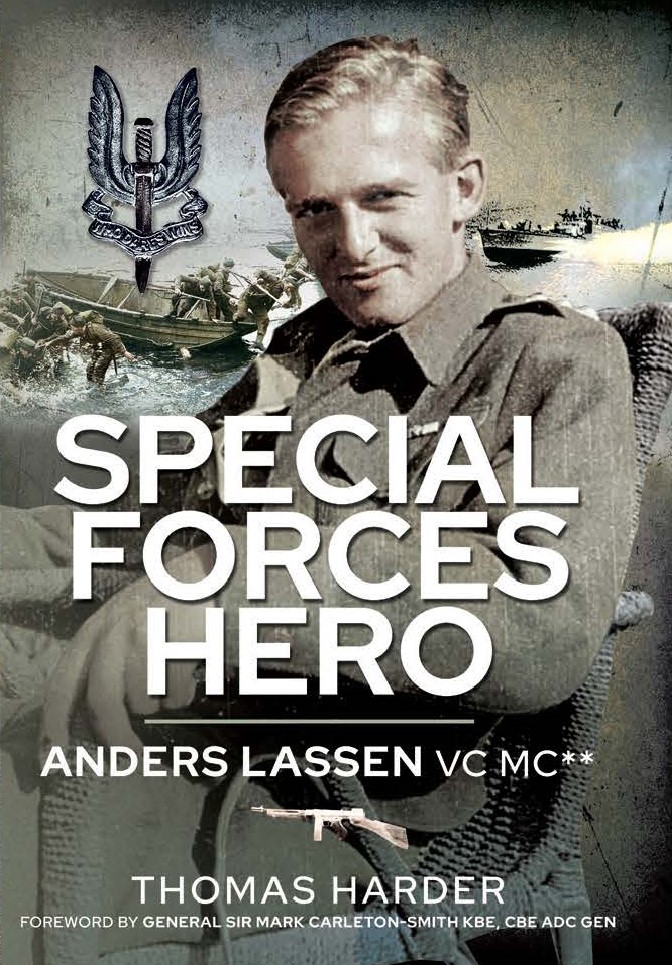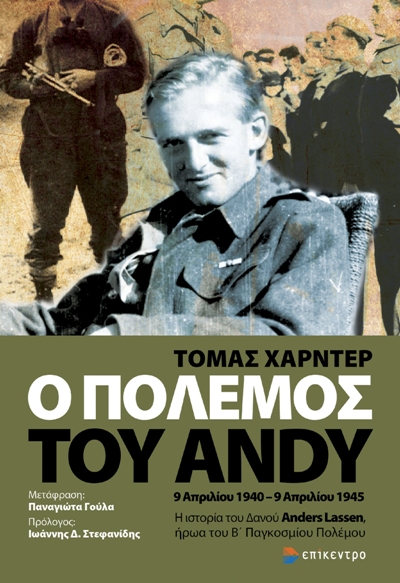

Order Special Forces Hero directly from Pen & Sword Books
Samples from Special Forces Hero - Anders Lassen VC, MC**
Anders Lassen-thessaloniki, October-November 1944
Anders Lassen - From Opertion Postmaster to Comacchio
A short talk obout Anders Lassen on Crete - Operation Albumen - SENFORCE
”Word is Vendetta” – The abduction of general Kreipe and the attack on Paros, April-May 1944.
At 07:05 on 1 May 1944, all Allied commands received the coded message “Word is Vendetta” – the signal to launch the final phase of the huge campaign to divert attention away from Overlord. Although the main objective was to make the enemy fear an imminent attack on the south of France by Allied forces in North Africa, the Allies also wanted to maintain – and preferably ramp up – the pretence that other parts of occupied Europe were also under threat. Everywhere from Norway to Denmark and France to Yugoslavia and Greece, resistance movements were stepping up their campaigns. Rumours were spread of an impending attack on Petsamo in the Norwegian-Finnish-Soviet border area. In the eastern Mediterranean and the Middle East, the British 9th and 10th Armies, despite mustering only one brigade apiece, were charged with conveying the impression that they were preparing to march into Greece and Bulgaria, and that Turkey was finally about to abandon its policy of neutrality and commit 40 divisions to the invasion force.[1]
On Crete, on 26 April 1944, an SOE team led by Patrick Leigh Fermor abducted the CO of the 22nd Airborne Infantry Division, Major General Heinrich Kreipe, who had just replaced Lieutenant General Friedrich-Wilhelm Müller. (The original plan had been to kidnap Müller, who had been responsible for massacres of Greek civilians and Italian PoWs). According to Patrick Leigh Fermor’s biographer, Artemis Cooper, Kreipe asked Fermor: ”Tell me, Major, what is the object of this hussar-stunt?” and “Even Paddy [Leigh Fermor] had to admit that there was no easy answer to that question.”[2]
The idea of a spectacular abduction on Crete was probably conceived by SOE Major Thomas J. Dunbabin who, in a report of May 1942 wrote about the possibility of capturing the crew of a small German observation post somewhere near the coast. The purpose would be to strengthen the morale of the Cretans by exposing the Germans’ weakness and to provoke the Germans to retaliate with atrocities that would make the locals hate them even more. Such an operation would also be useful for propaganda purposes, at home as well as abroad, in a time when British successes were only all too rare.
The abduction of small garrisons or of a general (Müller was mentioned several times, but so was the commandant of Crete, General Bruno Bräuer) was to be a recurring theme in Dunbabin’s and his colleague Fielding’s reports during the following two years. They generally presented the purpose as making the Germans insecure, undermining the myth of their invincibility, and strengthening the Cretans’ will to resist. German reprisals, which would obviously have to be expected, were sometimes described as a desirable objective, sometimes as a risk that should be minimised as far as possible, while at other times they were simply discounted as completely improbable.[3]
Kreipe’s question was a good one. What might have made sense in 1942, did not make equally good sense in 1944. Simple “subversion”, making the Germans feel insecure on Crete or rendering them ridiculous in the eyes of the locals, does not seem like a rational reason so late in the war. Neither does any British interest in interrogating Kreipe. The records of Kreipe’s interrogation by the CSDIC show not only that Kreipe (whose superiors considered him to be very resolute and cool in times of crisis) said very little of any importance, but also that the British seem to have had very little of any real interest to ask him about.[4]
The most plausible answer to why the SOE finally decided to undertake such a complicated and dangerous operation with so little impact in an island of very limited strategic interest where the Germans had a history of carrying out atrocities in response to sabotage operations etc., would seem to be deception – i.e. drawing the Germans’ attention to Greece and away from Normandy.
Kreipe’s abduction did not result in immediate German reprisals. On 27 April, the commandant og Fortress Crete, General Bruno Bräuer, did threaten with harsh retaliatory measures if Kreipe was not immediately released, but he did not carry them out, and his later proclamations were less drastic. It may have contributed to Bräuer’s moderate reaction that on 29 April 100 of “the best citizens of Heraklion” informed the General that they had formed a committee headed by the mayor, the bishop, the chief of police, and the chief prosecutor, with the purpose of getting the local population to help find Kreipe, so that the ”good policy of reconciliation”, introduced by Bräuer might continue.[5]
Bräuer’s policy of reconciliation did not prevent the Germans from destroying four villages in early May; however, these atrocities were not connected with the abduction of Kreipe. In August, when Bräuer had been replaced as commandant by Müller, the massacres broke loose in earnest: Four villages were burnt down, and hundreds of people were murdered. The Germans gave various reasons for these reprisals, among them the abduction of Kreipe. Dunbabin, who like his SOE colleague Ralph H. Stockbridge had spoken against the abduction, even though it had probably been his idea originally,[6] thought that the killings had nothing to do with Kreipe, but that at least part of their purpose was to make it harder for the German soldiers to desert by involving all of them in war crimes.[7] This seems like a rather farfetched explanation, and no other contemporary sources support it.
*
On Rhodes, the Greek Sacred Squadron attacked a radar station, while Raiding Forces stepped up the frequency of its incursions in the Aegean.[8] In the Cyclades, Sutherland’s campaign entered its second phase. On 9 May, Lassen and 12 men from P and K patrols sailed for Paros, and on 14 May J and Q patrols departed for Naxos.
Lassen and his men –sergeants Nicholson and Wait, the American medical orderly Porter Jarrell, Hank Hancock, Busty Sibbet, Patsy Henderson, Mick D’Arcy, Williams and other SBS men, accompanied by four members of the Greek Sacred Squadron – Second Lieutenant Kyriakos Sofoulis, Κ. Chalkias, Theodor Pyrialas and Stylianos Chrysos – landed on Glyfa Beach, near the southern tip of the 75-square-mile island of Paros at 22:00 on 13 May. [9] They spent the next day in a nearby cave until night fell, and then marched about eight miles up to Stroumboula, by the village of Lefke, not far from the German airfield (which was under construction but already being used by the Luftwaffe) near the villages of Prodromos, Marpissa and Marmara. Here, the raiders sought out the Stellas family, whose three sons, Manolis, Christos and Nikolas, were willing to provide them with assistance. Nikolas (23) worked on the building site and was well acquainted with the base and its security measures. Following a few hours’ rest and discussing the matter with the family, the raiders, guided by the three brothers, marched to a clifftop approx. 600 feet above the airfield. It was an arduous trip, in which they had to climb steep paths barely visible in the dark. Some of the men had a hard time keeping up – especially the radio operator, who had to contend with a 60-lb battery as well as his wireless set. Lassen always carried the bare minimum of kit, and was not exactly renowned for his willingness to help with other people’s gear. Nevertheless, on this occasion, he took the battery from the radio operator, picked up the pace and reached the top before everyone else. The men had marched for more than seven hours and were exhausted, so Lassen allowed them to rest all morning in a primitive shepherd’s hut, prior to an afternoon reconnoitring the surroundings and monitoring comings and goings at the base.
The night of May 15 was spent planning the details of the impending operation: Although it turned out that there were more German soldiers on Paros than expected – about 150 men – and that their positions were more scattered and therefore difficult to surprise than originally assumed, Lassen was not to be deterred. He divided his men into smaller groups, each with its own mission: to sabotage equipment on the airfield; destroy the radio stations in Prodromos and on a hilltop near Marmara; cut the phone line between Marpissa and the German observation post on the Kefalos mountain on the east coast; and abduct the commander of the base, Lieutenant Colonel Tabel.
*
While Lassen and his raiders continued their preparations, the RAF also tried to put the airfield on Paros out of action. On the morning of 15 May, a British reconnaissance plane photographed the base, just as a German Junkers Ju 52 transport plane was taking off. The same afternoon, at 15:20, four long-range twin-engine Beaufighter TF Mk.X planes set off from the base at Gambut in Libya. They first headed to the island of Tinos, about 25 miles north of Paros, where they dive-bombed a 100-ton German ship before heading for Paros. When they tried to destroy the airbase and other facilities, they were met with heavy anti-aircraft fire.
The German gunners shot down one Beaufighter (NE607/Q), which broke in two and exploded in the air before crashing near Lefkes. There were no survivors. The other three Beaufighters had only suffered superficial damage, but now found themselves under attack by four German Messerschmitt Bf-109 fighters, which downed a second Beaufighter (LZ404/K). Again, both crew members were killed. Despite being damaged, the other two Beaufighters made it back to base.
*
Lassen and his men went into action at 23:30 on the night of 16 May.
Nikolas Stella acted as guide for the first group, which was led by Lassen and consisted of eight SBS men and two members of the Greek Sacred Squadron. Its job was to attack a German barracks at the airfield and destroy its fuel depot, and also destroy a radio station on top of Yalios hill, northwest of Marmara.
The second group consisted of Second Lieutenant Kyriakos Sofoulis and another member of the Greek Sacred Squadron, four SBS men and the local resistance members Giannis Aliprantis and Police Chief Manolis Gryllakis, who was to act as guide. Their goal was to kidnap Lt. Col. Tabel from his quarters in Marmissa and destroy a nearby arms dump and a barracks housing 30 German soldiers. The third and fourth groups consisted of Antonis Delentas, Panagiotis Emmanuel Tsigonia, Dimitris Perantinos and other resistance fighters from Paros. They were tasked with putting radio and telephone installations in the village of Prodromos out of commission.
The attack on the airfield went awry almost from the beginning. The Greek guide who was supposed to show them the way to the bomb depot in a small church suddenly abandoned Hancock and Sibbet. The pair strayed too close to a German machine-gun position, which opened fire. Within seconds, the airfield reverberated with the sound of barking dogs and was lit up by flares. The two raiders beat a hasty retreat – terrified, they recalled later, at the thought of how Lassen would react when he heard that they had not returned fire. Lassen gave up on the gun position he had selected as his target.
However, not all of the Germans in the area had been alerted right away. The Greek partisans managed to sabotage the radio transmitter in Prodromos (killing four Germans in the process), destroy a warehouse and sever the phone line to Kefalos.
Lieutenant Kyriakos Sofoulis and Sergeant Nicholson led their group into Marpissa at 23:40 and struck so suddenly that the Germans had no chance to defend themselves. The Greek guides identified houses where the Germans were billeted, and Lewes bombs were used to clear them out. Three or four Germans were killed instantly, including Tabel’s adjutant, but the commander surrendered to Nicholson unscathed. The radio transmitter and weapons store were destroyed. As Nicholson led his prisoner through the village, some of the other raiders reacted to the sound of Tabel’s heavy hobnail boots (SBS boots had soft rubber soles) by opening fire on what they presumed was a German patrol. The commander was hit in the throat but again survived. Nicholson bandaged him and they moved on. Not far from the rendezvous point with the others, a grenade was lobbed at them. The blast blew both men off of their feet. Nicholson got back up, but his prisoner remained on the ground, dead or severely wounded, and this time Nicholson opted to leave him behind. Again, the assailants were SBS men who had mistaken them for a German patrol.
After the attack, Lassen, his men and their local Greek helpers (including the police chief, Grylakis, who had been shot and badly wounded) boarded boats from the fishing village of Piso Livadi, a few miles south-east of the airfield. Most of them had reached the rendezvous point on time, but not Jarrell, Henderson, D’Arcy or the young Nikolas Stellas. The pick-up boat could not wait – by dawn, it had to be hidden off the coast of Ikaria, about 44 miles north-east of Paros – so the trio were left behind.
Jarrell, Henderson and D’Arcy’s target had been the radio station in Marpissa. Following their encounter with the German gun emplacement, the raiders retreated to spend the rest of the night and the whole of the next day in hiding. It was the following night before they managed to sneak down to the rendezvous point. They were a day late, but when they made it to the beach they spotted flashing signals out at sea. The boat had returned to search for the missing men, either – as Nicholson later said – at Lassen’s insistence, or because it had been agreed in advance that if anybody failed to make it to the pick-up point on time then an attempt would be made to retrieve them the following day.
All of Lassen’s men made it back to Tewfiq safe and sound. Grilakis was sent to Cyprus, where doctors saved his life. But Nikolas Stellas was still missing.
The Germans picked him up near Marpissa. He was taken to Athens, interrogated and tortured, but did not give up the names of any other members of the local resistance. On 21 May, he was hanged on the square in Marpissa. The Germans forced local people to file past his corpse.
Tabel’s successor as head of Platzkommando Paros, Major Georg von Merenberg, was ordered by his superiors to execute 125 civilians on the island as punishment for the locals helping the raiders. Von Merenberg, whose career had stalled due to repeatedly and openly demonstrating his aversion to Nazism, thought this was a mistake. At first, he saw no alternative but to obey the order, as he risked being executed himself if he refused. However, Philotheos Zervakos, the abbot at the monastery in Longovardas, managed to arrange a meeting with von Merenberg, who was a great-grandchild of Czar Alexander II and his morganatic wife, and had grown up in a family with close ties to the Orthodox Church. The abbot offered to lay down his own life in exchange for the 125 hostages. When the German refused, the abbot asked to be executed along with his countrymen. In the end, von Merenburg agreed to spare the lives of the hostages in return for a guarantee from the abbot that nobody from the island would work with enemies of the Reich in future. This was not just a humane solution to the problem, but a politically wise move, which kept the the Germans on Paros safe and stopped the islanders’ antipathy towards them growing even stronger.
*
While Lassen and his men were on Paros, J and Q patrols landed on Naxos, where they made contact with a group of local partisans. Following events on Paros, the Germans, who had already established sound defensive positions, were on high alert. The SBS and the partisans attacked temporary German quarters in the town of Naxos, where an officer and 17 soldiers were billeted. After an hour of street fighting, the raiders and their Greek allies pulled back. They remained in hiding for three days until they were picked up and returned to base. Three men suffered minor wounds and one contracted malaria.[10]


